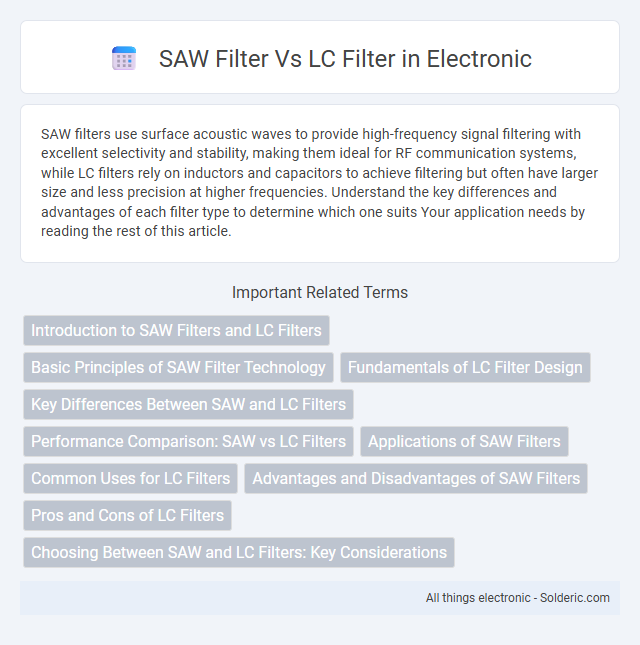SAW filters use surface acoustic waves to provide high-frequency signal filtering with excellent selectivity and stability, making them ideal for RF communication systems, while LC filters rely on inductors and capacitors to achieve filtering but often have larger size and less precision at higher frequencies. Understand the key differences and advantages of each filter type to determine which one suits Your application needs by reading the rest of this article.
Comparison Table
| Feature | SAW Filter | LC Filter |
|---|---|---|
| Technology | Surface Acoustic Wave | Inductor-Capacitor Circuit |
| Frequency Range | 100 MHz to 3 GHz | Up to 100 MHz |
| Size | Compact, miniature | Larger, bulkier |
| Insertion Loss | Low to moderate (1-3 dB) | Moderate to high |
| Quality Factor (Q) | High Q | Lower Q |
| Temperature Stability | Moderate (affected by stress and temp) | Better temperature stability |
| Cost | Higher (due to complex fabrication) | Lower (simple components) |
| Application | RF front-end filters, mobile devices | Power supplies, audio circuits |
Introduction to SAW Filters and LC Filters
SAW filters utilize surface acoustic wave technology to achieve high-frequency signal filtering with excellent selectivity and low insertion loss, making them ideal for RF applications. LC filters, composed of inductors (L) and capacitors (C), provide versatile and cost-effective frequency filtering in both low- and high-frequency circuits, but may exhibit higher losses and less precision compared to SAW filters. Your choice between SAW and LC filters depends on the required frequency range, insertion loss, and application-specific performance criteria.
Basic Principles of SAW Filter Technology
SAW filters operate by converting electrical signals into surface acoustic waves on a piezoelectric substrate, which then travel through interdigital transducers to filter specific frequencies with high precision. Unlike LC filters that use inductors and capacitors to create resonant circuits, SAW filters leverage mechanical wave propagation for miniaturized, stable, and high-frequency signal processing. Your choice of filter depends on the application requirements for size, frequency response, and temperature stability, where SAW filters often excel in RF communication devices.
Fundamentals of LC Filter Design
LC filters rely on inductors (L) and capacitors (C) to create resonant circuits that selectively pass or block specific frequency ranges. The design fundamentals involve calculating the values of L and C components to achieve desired cutoff frequencies, insertion loss, and impedance matching, ensuring signal integrity. You must consider quality factors (Q), component tolerances, and parasitic effects to optimize filter performance in applications like RF and communications.
Key Differences Between SAW and LC Filters
SAW filters utilize piezoelectric substrates to generate surface acoustic waves, providing high-frequency selectivity and compact size, while LC filters employ inductors and capacitors to achieve frequency filtering with broader bandwidth and simpler design. SAW filters exhibit superior performance in RF front-ends with low insertion loss and stable temperature characteristics, whereas LC filters offer flexibility in tuning and integration at lower frequencies. The choice between SAW and LC filters depends on application requirements such as frequency range, size constraints, and insertion loss tolerance.
Performance Comparison: SAW vs LC Filters
SAW filters deliver superior high-frequency performance with excellent selectivity and low insertion loss, making them ideal for RF and microwave applications. LC filters offer greater flexibility in design and tuning but generally have higher insertion loss and lower Q-factor compared to SAW filters. Your choice depends on the specific frequency range and performance requirements, with SAW filters excelling in precision and LC filters providing cost-effective solutions for lower frequencies.
Applications of SAW Filters
SAW filters are widely utilized in wireless communication systems, including smartphones, GPS devices, and RF modules, due to their excellent frequency selectivity and compact size. These filters efficiently suppress unwanted frequencies in high-frequency bands, making them ideal for mobile networks, satellite communication, and radar systems. Their reliability in handling high-frequency signals outperforms LC filters in applications demanding precise signal filtering and low insertion loss.
Common Uses for LC Filters
LC filters are commonly used in radio frequency applications for signal tuning, noise reduction, and impedance matching due to their ability to handle high frequencies with minimal loss. These filters are essential in wireless communication devices, audio systems, and power supplies to ensure signal integrity and stable performance. Your design can benefit from LC filters when requiring reliable filtering of electromagnetic interference and precise frequency selection.
Advantages and Disadvantages of SAW Filters
SAW filters offer superior frequency selectivity and compact size, making them ideal for high-frequency applications such as RF front-ends in wireless communication devices. They provide low insertion loss and high stability but are limited by narrower bandwidth and reduced power handling compared to LC filters. Despite higher manufacturing costs and sensitivity to temperature variations, SAW filters excel in miniaturization and integration in modern electronics.
Pros and Cons of LC Filters
LC filters offer high selectivity and low insertion loss, making them ideal for precise frequency tuning in RF circuits. However, they tend to be bulkier and more sensitive to component variations and temperature changes compared to SAW filters. Their inductors and capacitors can introduce parasitic effects, limiting performance at very high frequencies.
Choosing Between SAW and LC Filters: Key Considerations
Choosing between SAW (Surface Acoustic Wave) and LC (inductor-capacitor) filters depends on frequency range, insertion loss, and size requirements. SAW filters excel in high-frequency applications above 100 MHz with superior selectivity and stability, making them ideal for RF front-ends in wireless communication devices. LC filters offer greater flexibility at lower frequencies below 100 MHz, often providing lower cost and easier integration in power supply noise reduction and audio circuits.
SAW Filter vs LC Filter Infographic

 solderic.com
solderic.com